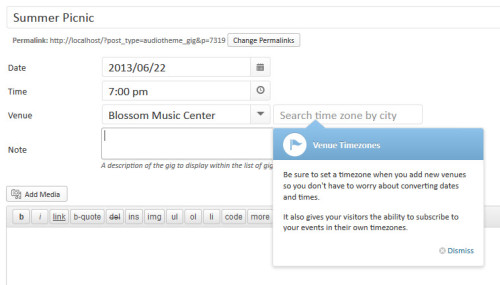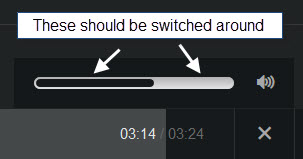 Custom post types are one of those things in WordPress that’s been difficult for me to figure out. However, after reviewing the Americanaura theme combined with the AudioTheme framework, I have a better understanding of why custom post types are so cool.
Custom post types are one of those things in WordPress that’s been difficult for me to figure out. However, after reviewing the Americanaura theme combined with the AudioTheme framework, I have a better understanding of why custom post types are so cool.
Unlike a traditional theme framework, the majority of the functionality is located in the AudioTheme Plugin. Without this plugin, AudioTheme themes will not function. This setup enables the separation between code and design. The nuts and bolts behind this theme are the custom post types. There are three primary post types, Gigs, Discography, and Videos. Each one has a set of custom meta boxes like record details, or ticket prices. While the screenshot shows off a tool-tip, I would like to see more of these added. For example, when adding a new gig, there is a custom meta box for Tickets. One of the fields is for configuring a tickets URL. It’s not obvious if this URL is something within the theme or a URL to an outside source such as TicketMaster. A simple tool-tip could explain exactly what that field is for. However, most of the theme is self-explanatory.
One of the coolest features within this framework is the jukebox. The source of music can come from a record or a list of tracks. Once the jukebox is set up, a media player will show up at the bottom of the browser window giving visitors the option to browse through tracks, stop/play, click to a specific point in the music timeline, and volume control. While it’s a small nitpick, I found the volume control confusing. In most media players, moving the slider down to up or left to right will increase volume. In the jukebox, moving from left to right will increase the volume but the way it’s displayed makes it look as though the volume is being lowered. A simple color switch would solve this problem.
Both the themes and the plugin framework are licensed under the GPLv2, the same license as WordPress. While checking out, you’ll notice text that stipulates how many sites you can use the framework on. This is related to how many sites can receive support and is not a restriction of use. Because of the separation between theme and plugin, each has its own price tag. If you’re a theme developer, you’ll probably want to look at purchasing only the AudioTheme framework and design around it. But for non-coders, you’ll most likely need to buy both a theme and the framework. However, the website states that any theme purchase will come with a personal license to use the framework.
It’s not the most user-friendly setup but I like the versatility it provides them as a company. By keeping the framework separate, AudioThemes can work with other companies to build designs around their plugin as they did with Press75. I’m hoping that in the future, they have a ton of designs to choose from.
Conclusion:
Overall, the theme I reviewed along with the framework was not only easy to install, but easy to use as well. I remember 5-8 years ago that some of the features that come standard with the AudioTheme Framework and with WordPress were very hard to come by in any other CMS. Take the Jukebox for example. Something like the Jukebox 5-8 years ago would involve installing hacks or using some sort of third-party service. This example of utilizing custom post types has taught me why their versatility is such an exciting component of WordPress. Based on this theme and some other examples I’ve seen, when a good design is paired with custom post types, magical things happen. I can’t wait to come across indie or established artists utilizing AudioTheme to get their music to the world, without the need for a middle man.



Excellent review, Jeffro. We really appreciate you taking the time to look at AudioTheme and writing about it. We’ll certainly consider your critiques and see where we can improve.
Just to clarify the pricing, any theme purchase does indeed come with a Personal framework license to use on a single site, so one purchase is all that’s needed in most cases. The framework itself will also work with any theme, but may require markup and style changes to integrate seamlessly. Like you mentioned, it is a good option for theme developers that want to use an existing or custom theme.
I can understand how it might be a little confusing, but we feel this route provides the most flexibility for customers, while still allowing us to improve and support the framework.
Thanks again for the write-up!